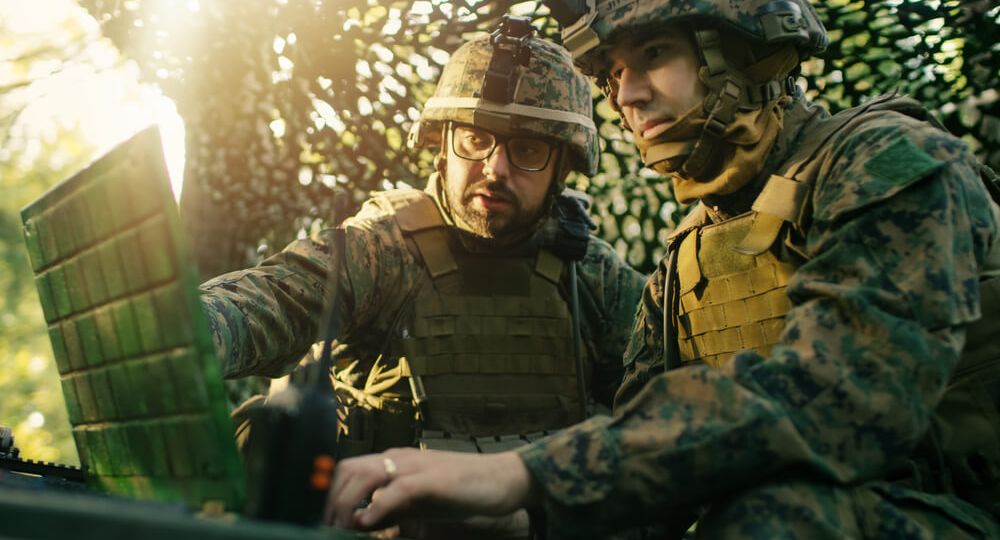
Arms industry from decades is developing very dynamically. Weapons and military companies actively invest in innovative scientific research to introduce better technological solutions and improve the quality of defense products. What are the latest trends in this sector? We write about this below.
Development of artificial intelligence.
This is a very broad topic, so we will only point out a few aspects in which AI determines the future of the military sector. Artificial intelligence is used almost everywhere today, including the defense sector for training the military, creating advanced weapons, surveillance purposes and ensuring cybersecurity. The aviation sector, for example, uses artificial intelligence to manage air traffic, train pilots and optimize fuel consumption. During a flight, for example, pilot can work with an AI assistant to improve overall operational efficiency.
Other examples where artificial intelligence is used include:
- Training military personnel using AI-based simulations and virtual environments.
- Geospatial analysis and monitoring recordings, e.g. drones, to identify objects and patterns.
- Using AI to analyze data in real time and thus enable more informed decisions.
3D printing
3D printing, a form of additive manufacturing, allows components and parts to be produced using less material than traditional methods. Currently, the aerospace and defense industry are one of the largest users of additive manufacturing technology: it is used to create among others: rocket bodies, building rocket engines, accelerating the production of aircraft or producing individual elements of a larger structure. 3D printing has enormous benefits. Light components for drones, vehicles and weapons printed using this technology reduce fuel consumption, and thanks to portable 3D printers, items such as food, spare parts and shelters can also be produced on demand. Continuous improvements in 3D printing technology will undoubtedly continue to be a growing technology trend in defense – the 3D printing defense market is estimated to grow at a 25% CAGR from 2022 ($1.5 billion) to 2030 ($14 billion). USD).
Cyber warfare
Cybernetic warfare is no longer abstract, it became real. Cyberattacks pose a serious and ongoing security threat. Therefore, the development of technologies and systems for both combat and cyber defense will be a trend in the military industry. Mark Hughes, president of security at DXC Technology, points to four pillars of defense cybersecurity: maintaining operational integrity, protecting classified information, supply chain security and deterring industrial espionage.
Sustainable development
Protection of the planet, resources, sustainable development and ecology are concepts that now appear very often in the international space – this also applies to the military industry. Government regulations, international regulations or commitments set by communities and organizations in the field of sustainable development impose an obligation to achieve zero emissions by 2050 in armed forces around the world. And it is not without reason, as the world’s armed forces and the industries that supply their equipment are estimated to generate as much as 6% of all global CO2 emissions. Therefore, sustainable development will certainly be a trend in the military industry. The defense sector must make efforts to minimize harmful environmental impacts while future-proofing its processes against climate-related disasters. An example of this is the US Naval Air Force, which has already tested piloted all-electric and hybrid-electric flight demonstrators, achieving quiet, zero-emission flight.
Internet of Things (IoT)
IoT (Internet of things) is a network of objects “things” that are equipped with sensors, software and other technologies to connect and exchange data with other devices and systems via the Internet. IoT connects all elements that can transmit data within one network, without the need for interaction between people or between a person and a computer. Military applications of IoT improve defense capabilities and the battlefield. These include connected ships, tanks, aircraft, drones, soldiers and operational bases that work together in a coherent network to increase situational awareness, risk assessment and response times. IoT can be used, for example, in:
- Monitoring soldier’s health: thanks to the use of sensors in uniforms, it is possible to monitor a soldier’s heart rate and body temperature. The collected data can then be made available to doctors in real time, which allows the necessary assistance to be organized for each soldier in advance.
- Real-time management of equipment and vehicles thanks to data collection using vehicle sensors. Location, fuel consumption, mechanical condition and other parameters allow you to detect problems and solve them quickly.
Summary
The development of military industry and technology is not slowing down, on the contrary – it is developing very dynamically and quickly, and the above trends are only an outline of what will determine the directions of development of the military industry in the future.








